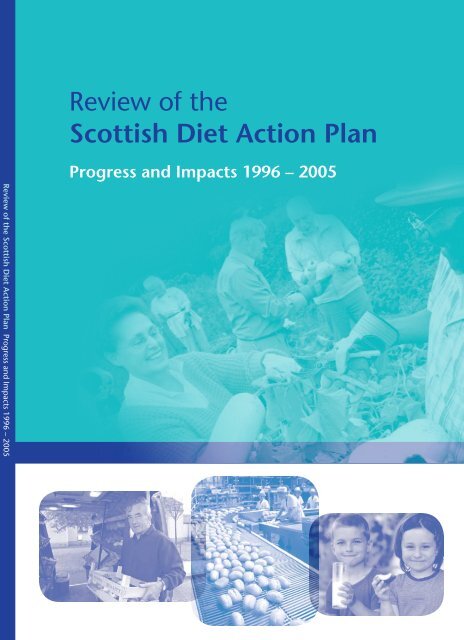Review of the Scottish Diet Action Plan - Food and Health Alliance
Review of the Scottish Diet Action Plan - Food and Health Alliance
Review of the Scottish Diet Action Plan - Food and Health Alliance
You also want an ePaper? Increase the reach of your titles
YUMPU automatically turns print PDFs into web optimized ePapers that Google loves.
<strong>Review</strong> <strong>of</strong> <strong>the</strong><br />
<strong>Scottish</strong> <strong>Diet</strong> <strong>Action</strong> <strong>Plan</strong><br />
<strong>Review</strong> <strong>of</strong> <strong>the</strong> <strong>Scottish</strong> <strong>Diet</strong> <strong>Action</strong> <strong>Plan</strong> Progress <strong>and</strong> Impacts 1996 – 2005<br />
Progress <strong>and</strong> Impacts 1996 – 2005
Published by <strong>Health</strong> Scotl<strong>and</strong><br />
Edinburgh Office:<br />
Woodburn House<br />
Canaan Lane<br />
Edinburgh EH10 4SG<br />
Glasgow Office:<br />
Clifton House<br />
Clifton Place<br />
Glasgow G3 7LS<br />
© NHS <strong>Health</strong> Scotl<strong>and</strong>, 2006<br />
ISBN: 1-84485-378-0<br />
Ref: 2005/2006 RE36<br />
<strong>Health</strong> Scotl<strong>and</strong> is a WHO Collaborating Centre<br />
for <strong>Health</strong> Promotion <strong>and</strong> Public <strong>Health</strong> Development.<br />
This publication has been printed on100% recycled paper.
<strong>Review</strong> <strong>of</strong> <strong>the</strong><br />
<strong>Scottish</strong> <strong>Diet</strong> <strong>Action</strong> <strong>Plan</strong><br />
Progress <strong>and</strong> Impacts 1996–2005<br />
<strong>Review</strong> panel<br />
Pr<strong>of</strong>essor Tim Lang<br />
Dr Elizabeth Dowler<br />
Pr<strong>of</strong>essor David J. Hunter<br />
September 2006
Membership <strong>of</strong> <strong>the</strong> <strong>Scottish</strong><br />
<strong>Diet</strong> <strong>Action</strong> <strong>Plan</strong> (SDAP)<br />
review panel<br />
SDAP <strong>Review</strong> Panel<br />
Pr<strong>of</strong>essor Tim Lang<br />
Chair<br />
Pr<strong>of</strong>essor <strong>of</strong> <strong>Food</strong> Policy, City University, London<br />
Dr Elizabeth Dowler<br />
Expert member (Public <strong>Health</strong> Nutrition)<br />
Reader in <strong>Food</strong> <strong>and</strong> Social Policy, University <strong>of</strong> Warwick<br />
Registered Public <strong>Health</strong> Nutritionist<br />
Pr<strong>of</strong>essor David J. Hunter<br />
Expert member (Public <strong>Health</strong> Policy)<br />
Pr<strong>of</strong>essor <strong>of</strong> <strong>Health</strong> Policy <strong>and</strong> Management, Durham University<br />
Chair UK Public <strong>Health</strong> Association<br />
Secretariat<br />
Dr Cathy Higginson<br />
SDAP <strong>Review</strong> Coordinator<br />
<strong>Food</strong> <strong>and</strong> <strong>Health</strong> Programme Manager, <strong>Health</strong> Scotl<strong>and</strong><br />
Dr Erica Wimbush<br />
Coordinator <strong>and</strong> Editor <strong>of</strong> Policy <strong>Review</strong> Series<br />
Head <strong>of</strong> Policy Evaluation <strong>and</strong> Appraisal, <strong>Health</strong> Scotl<strong>and</strong><br />
Jenny Shiell <strong>and</strong> Kate Barlow<br />
SDAP <strong>Review</strong> Administrators, <strong>Health</strong> Scotl<strong>and</strong><br />
Writer<br />
Dr Helen Crawley<br />
Writer for <strong>the</strong> panel<br />
Public <strong>Health</strong> Nutritionist
Executive summary<br />
The purpose <strong>of</strong> this policy review was to examine <strong>the</strong> progress that has been made<br />
in <strong>the</strong> implementation <strong>of</strong> <strong>the</strong> <strong>Scottish</strong> <strong>Diet</strong> <strong>Action</strong> <strong>Plan</strong> (SDAP) since 1996 – what has<br />
been achieved <strong>and</strong> what remains to be done – to consider its impacts to date, <strong>and</strong> to<br />
identify strategic priorities for Scotl<strong>and</strong>’s future policy on improving <strong>the</strong> <strong>Scottish</strong> diet.<br />
An external <strong>and</strong> independent review panel was appointed by <strong>Health</strong> Scotl<strong>and</strong> in July<br />
2005 <strong>and</strong> asked to report to <strong>the</strong> <strong>Scottish</strong> <strong>Food</strong> <strong>and</strong> <strong>Health</strong> Council (SFHC), chaired by<br />
<strong>the</strong> Deputy Minister for <strong>Health</strong> <strong>and</strong> Community Care. The panel sought evidence from<br />
bodies listed in <strong>the</strong> 1996 SDAP <strong>and</strong> o<strong>the</strong>rs who were subsequently identified, attended<br />
meetings, held six days <strong>of</strong> hearings <strong>and</strong> conducted two preliminary feedback sessions<br />
with stakeholders. This report summarises <strong>the</strong> panel’s main findings <strong>and</strong> conclusions.<br />
Fur<strong>the</strong>r documents, commissioned reports <strong>and</strong> written submissions are available in<br />
<strong>the</strong> Evaluation section <strong>of</strong> <strong>the</strong> <strong>Health</strong> Scotl<strong>and</strong> website (www.healthscotl<strong>and</strong>.com).<br />
The SDAP was a timely policy intervention in 1996, which was endorsed by <strong>the</strong> new<br />
devolved government when it took <strong>of</strong>fice in 1999. In <strong>the</strong> mid-1990s, Scotl<strong>and</strong> had a<br />
poor record <strong>of</strong> diet-related ill-health, <strong>and</strong> <strong>the</strong> aim <strong>of</strong> <strong>the</strong> SDAP dietary targets was to<br />
reduce diet-related mortality <strong>and</strong> morbidity in Scotl<strong>and</strong>, particularly that related to<br />
illnesses such as heart disease, cancer <strong>and</strong> diabetes <strong>and</strong> to being overweight/obese.<br />
In this way, <strong>the</strong> SDAP dietary targets were, <strong>and</strong> remain, valid <strong>and</strong> laudable in <strong>the</strong>ir<br />
public health intent <strong>and</strong> sit comfortably with Scotl<strong>and</strong>’s o<strong>the</strong>r social, economic <strong>and</strong><br />
political goals.<br />
The panel evaluated <strong>the</strong> progress made in <strong>the</strong> implementation <strong>of</strong> <strong>the</strong> SDAP<br />
recommendations over <strong>the</strong> last 10 years. This was based on evidence supplied to <strong>the</strong><br />
panel by a large number <strong>of</strong> sources <strong>and</strong> stakeholders. Examples in which substantial<br />
progress has been made include:<br />
vi<br />
•<br />
•<br />
•<br />
•<br />
•<br />
•<br />
The appointment <strong>of</strong> a national level <strong>Food</strong> <strong>and</strong> <strong>Health</strong> Coordinator within <strong>the</strong> <strong>Scottish</strong><br />
Executive with appropriate responsibility (to provide national level leadership to<br />
drive SDAP implementation <strong>and</strong> encourage cross-government working).<br />
The creation <strong>of</strong> alliances on food <strong>and</strong> health (to increase policy leverage).<br />
The formation <strong>of</strong> <strong>the</strong> <strong>Scottish</strong> Community <strong>Diet</strong> Project (SCDP) within <strong>the</strong> <strong>Scottish</strong><br />
Consumer Council (to support community level food initiatives, especially in lowincome<br />
areas/groups).<br />
The delivery <strong>of</strong> dietary information to expectant mo<strong>the</strong>rs (to improve infant <strong>and</strong><br />
neonatal health).<br />
Support for breastfeeding by appropriately trained health pr<strong>of</strong>essionals (to<br />
improve infant diet <strong>and</strong> child health).<br />
The development <strong>of</strong> health promoting schools <strong>and</strong> a whole school approach<br />
to healthy eating, catering <strong>and</strong> supply (to improve dietary education <strong>and</strong> <strong>the</strong><br />
provision <strong>of</strong> healthy food in schools).
•<br />
•<br />
•<br />
•<br />
•<br />
<strong>Review</strong> <strong>of</strong> <strong>the</strong> SDAP: Progress <strong>and</strong> Impacts 1996–2005<br />
The provision <strong>of</strong> free fruit in schools (to intervene directly in children’s diets).<br />
The setting <strong>of</strong> nutritional st<strong>and</strong>ards for school meals (to provide a lead in public<br />
sector catering).<br />
The distribution <strong>of</strong> nutritional advice to every household in Scotl<strong>and</strong> (to empower<br />
consumers).<br />
The development <strong>of</strong> health education campaigns <strong>and</strong> resources on healthy<br />
eating (to raise awareness about healthy eating messages <strong>and</strong> support health<br />
pr<strong>of</strong>essionals).<br />
The breeding <strong>and</strong> selling <strong>of</strong> leaner livestock (to reduce fat in <strong>the</strong> diet).<br />
The panel highlighted four particular areas <strong>of</strong> success: an improvement in breastfeeding<br />
rates; an improvement in food <strong>and</strong> diet in schools; support for community food<br />
initiatives; <strong>and</strong> <strong>the</strong> production <strong>of</strong> health education resources <strong>and</strong> marketing<br />
campaigns. Rates <strong>of</strong> initiating <strong>and</strong> maintaining breastfeeding have risen sharply in all<br />
social classes. Breastfeeding rates in Scotl<strong>and</strong> are now above those in Engl<strong>and</strong> <strong>and</strong><br />
Wales, with 70% <strong>of</strong> <strong>Scottish</strong> mo<strong>the</strong>rs now reported to initiate breastfeeding, compared<br />
with 55% <strong>of</strong> mo<strong>the</strong>rs in 1995. There is also evidence <strong>of</strong> improved outcomes from <strong>the</strong><br />
introduction <strong>of</strong> free fruit in schools <strong>and</strong> from guidance on <strong>the</strong> nutritional content <strong>of</strong><br />
school meals. Systematic support for community food initiatives has helped to give a<br />
voice to issues regarding food inequalities at <strong>the</strong> national level <strong>and</strong>, with small-scale<br />
financial investment, has helped to raise skills, access <strong>and</strong> consumption for some<br />
in low-income areas. However, overall, <strong>the</strong> reach <strong>and</strong> population impact <strong>of</strong> <strong>the</strong>se<br />
initiatives appears small.<br />
The initiatives that have been effective appear to share some common features <strong>of</strong><br />
success, which provide important lessons for <strong>the</strong> future:<br />
•<br />
•<br />
•<br />
•<br />
•<br />
Longevity: <strong>the</strong>se initiatives <strong>of</strong>ten started before <strong>the</strong> SDAP was implemented or<br />
were part <strong>of</strong> <strong>the</strong> early implementation actions that were taken, meaning that<br />
change has been achieved over a longer time period. Many <strong>of</strong> <strong>the</strong> o<strong>the</strong>r SDAP<br />
recommendations were not implemented until after 2001 with <strong>the</strong> appointment <strong>of</strong><br />
<strong>the</strong> national <strong>Food</strong> <strong>and</strong> <strong>Health</strong> Coordinator.<br />
They have benefited from a sustained <strong>and</strong> increasing commitment <strong>of</strong> resources<br />
to <strong>the</strong> achievement <strong>of</strong> defined objectives.<br />
Their delivery involved action by a defined body <strong>of</strong> pr<strong>of</strong>essionals who could take<br />
responsibility for driving action <strong>and</strong> change.<br />
Local action has been supported at national level by communications campaigns<br />
to increase public awareness <strong>and</strong> help shift public attitudes.<br />
Regulatory <strong>and</strong> legislative actions have been used to consolidate <strong>and</strong> mainstream<br />
changes <strong>and</strong> to build consumer dem<strong>and</strong> at an institutional level through public<br />
procurement systems.<br />
There were a number <strong>of</strong> action areas in which implementation was judged by <strong>the</strong><br />
panel to be minimal according to <strong>the</strong> evidence available, <strong>and</strong> which suggest that <strong>the</strong><br />
food supply chain was not fully engaged. These include:<br />
• reducing <strong>the</strong> production <strong>of</strong> dairy fat <strong>and</strong> finding alternative non-food markets for<br />
butter fat<br />
• providing basic training in nutrition for those working in <strong>the</strong> food industry <strong>and</strong> <strong>the</strong><br />
hospitality management curriculum<br />
• increasing consumer dem<strong>and</strong> for fruit <strong>and</strong> vegetables via <strong>the</strong> catering service<br />
<strong>and</strong> primary producers.<br />
vii
Executive summary<br />
However, despite <strong>the</strong> considerable progress that has been made in implementing <strong>the</strong><br />
SDAP recommendations, overall <strong>the</strong> action taken has not had a significant impact<br />
on population trends in food consumption <strong>and</strong> nutrient intakes in Scotl<strong>and</strong> over <strong>the</strong><br />
last 10 years. A separate report from <strong>the</strong> <strong>Food</strong> St<strong>and</strong>ards Agency Scotl<strong>and</strong> (FSAS),<br />
as well as <strong>the</strong> panel’s own analysis, shows that <strong>the</strong> dietary targets set for 2005 are<br />
overwhelmingly not being achieved.<br />
The only dietary target in which <strong>the</strong> trends are moving in <strong>the</strong> right direction (but where<br />
change has not been as fast as anticipated) is <strong>the</strong> level <strong>of</strong> intake <strong>of</strong> total fat as a<br />
percentage <strong>of</strong> food energy: this has fallen from around 40% to an average <strong>of</strong> about<br />
38%, whereas <strong>the</strong> target was to reduce this to no more than 35%. 1<br />
There has been no change in o<strong>the</strong>r food <strong>and</strong> nutrient intakes:<br />
•<br />
•<br />
•<br />
•<br />
•<br />
Daily consumption <strong>of</strong> fruit <strong>and</strong> vegetables: average intakes remain at around<br />
246 g a day, whereas <strong>the</strong> target was to achieve a minimum <strong>of</strong> 400 g per person<br />
per day.<br />
Saturated fatty acids: average intakes have fallen from about 15.6% to 15.2% <strong>of</strong><br />
food energy, whereas <strong>the</strong> target was to reduce this to no more than 11% <strong>of</strong> food<br />
energy.<br />
Total complex carbohydrates: <strong>the</strong> target was to increase average intakes by 25%<br />
but intakes have remained at around 141 g per person per week.<br />
Weekly consumption <strong>of</strong> oil-rich fish: <strong>the</strong> target was to double consumption from<br />
44 g per person per week to 88 g per person per week, but consumption has<br />
remained at around 34 g.<br />
Consumption <strong>of</strong> breakfast cereals: <strong>the</strong> target was to double consumption from<br />
18 g per person per day, but consumption levels have remained unchanged.<br />
Of greatest concern are those areas in which <strong>the</strong> trends are moving in <strong>the</strong> wrong<br />
direction:<br />
•<br />
•<br />
•<br />
•<br />
Intakes <strong>of</strong> non-milk extrinsic (NME) sugars (those implicated in tooth decay) have<br />
risen ra<strong>the</strong>r than being held constant (target for adults) or being reduced (target<br />
for children).<br />
Potato consumption has fallen by 25% instead <strong>of</strong> increasing by 25%.<br />
Bread consumption has fallen by 12% instead <strong>of</strong> increasing by 45%, with <strong>the</strong><br />
consumption <strong>of</strong> brown/wholemeal bread falling by 25%.<br />
Overall, <strong>the</strong> consumption levels <strong>of</strong> <strong>the</strong> ‘healthy’ foods that were targeted to<br />
increase are significantly lower in <strong>the</strong> most deprived groups <strong>of</strong> <strong>the</strong> population.<br />
Trends in Scotl<strong>and</strong>’s food consumption <strong>and</strong> nutrient intake in <strong>the</strong> last 10 years have,<br />
in part, been shaped by macroeconomic changes in food retailing <strong>and</strong> catering<br />
<strong>and</strong> related shifts in eating patterns. For example, <strong>the</strong> rising trend in sugar intakes<br />
is linked to changing patterns <strong>of</strong> eating <strong>and</strong> drinking outside <strong>the</strong> home in Scotl<strong>and</strong>,<br />
where <strong>the</strong>re has been a worrying rise in <strong>the</strong> consumption <strong>of</strong> s<strong>of</strong>t drinks, snacks <strong>and</strong><br />
viii<br />
1 In practice, reducing <strong>the</strong> proportion <strong>of</strong> food energy obtained from fat is possible by increasing intakes <strong>of</strong> complex carbohydrates,<br />
sugars or protein – all <strong>of</strong> which can provide energy in <strong>the</strong> diet. Of <strong>the</strong>se, <strong>the</strong> most desired change is an increase in <strong>the</strong> energy<br />
obtained from complex carbohydrates. The small decrease in <strong>the</strong> proportion <strong>of</strong> food energy from fat shown here should be seen<br />
in <strong>the</strong> context <strong>of</strong> <strong>the</strong> increase in <strong>the</strong> proportion <strong>of</strong> energy from sugars <strong>and</strong> <strong>the</strong> lack <strong>of</strong> change in <strong>the</strong> intake <strong>of</strong> complex carbohydrates<br />
that was also noted
<strong>Review</strong> <strong>of</strong> <strong>the</strong> SDAP: Progress <strong>and</strong> Impacts 1996–2005<br />
confectionery in recent years. S<strong>of</strong>t drinks, confectionery <strong>and</strong> lager/beer are <strong>the</strong> three<br />
greatest contributors to sugar intakes.<br />
The panel considered a number <strong>of</strong> possible reasons why <strong>the</strong> dietary targets have not<br />
been met despite considerable success in implementing <strong>the</strong> SDAP recommendations.<br />
The most plausible explanations include:<br />
•<br />
•<br />
•<br />
•<br />
•<br />
•<br />
The direction required to achieve <strong>the</strong> level <strong>of</strong> change defined by <strong>the</strong> dietary targets<br />
underestimated <strong>the</strong> impact <strong>of</strong> inequalities.<br />
Resources <strong>and</strong> initiatives have been spread too thinly across a broad range <strong>of</strong><br />
actions ra<strong>the</strong>r than focusing on achieving population-level impact within a few<br />
priority areas.<br />
The broad range <strong>of</strong> actions recommended was not transparently or consistently<br />
linked to <strong>the</strong> narrow range <strong>of</strong> food <strong>and</strong> nutrient targets identified.<br />
The SDAP has adopted a wholly consensual partnership approach to ‘working<br />
with’ <strong>the</strong> food industry <strong>and</strong> thus underplayed <strong>the</strong> powerful role <strong>of</strong> <strong>the</strong> food supply<br />
chain in shaping food content, access, availability <strong>and</strong> consumer dem<strong>and</strong> over<br />
<strong>the</strong> last 10 years, such as <strong>the</strong> period <strong>of</strong> rapid restructuring <strong>of</strong> <strong>the</strong> food industry or<br />
<strong>the</strong> undermining <strong>of</strong> health messages by powerful marketing <strong>and</strong> advertising <strong>of</strong><br />
foods <strong>and</strong> drinks. The SDAP has not deployed <strong>the</strong> full set <strong>of</strong> policy tools available,<br />
most notably those <strong>of</strong> exercising regulatory <strong>and</strong> legislative powers <strong>of</strong> government<br />
to control <strong>the</strong> food supply chain <strong>and</strong> help create dem<strong>and</strong>.<br />
The areas where little or no progress has been made with implementation<br />
suggest that, until <strong>the</strong> recent public debate about rapidly rising obesity, <strong>the</strong> food<br />
supply chain has not been fully engaged with <strong>the</strong> need to change. Institutions<br />
<strong>and</strong> leadership across <strong>the</strong> supply chain have not been aligned effectively.<br />
At <strong>the</strong> regional level, SDAP implementation <strong>and</strong> prioritisation has appeared<br />
uneven, accountability for local implementation has not been clear <strong>and</strong> linkages<br />
with o<strong>the</strong>r relevant policy str<strong>and</strong>s have been inadequate.<br />
Each <strong>of</strong> <strong>the</strong> above reasons provides a plausible explanation for why <strong>the</strong> overall changes<br />
sought by <strong>the</strong> SDAP have not been achieved, although none alone is a sufficient<br />
explanation. There is no single, simple reason for <strong>the</strong> SDAP targets not being met.<br />
The panel concluded that, although some advances in thinking <strong>and</strong> practice have<br />
been made <strong>and</strong> some initiatives have been inspiring as well as effective, <strong>the</strong> total<br />
shift required <strong>and</strong> sought by <strong>the</strong> SDAP has not yet been realised. There are some<br />
important lessons for future policy:<br />
• To achieve population-level impact, a more focused <strong>and</strong> prioritised approach to<br />
policy <strong>and</strong> implementation may prove to be more effective than a broad range,<br />
or ‘scattergun’, <strong>of</strong> initiatives.<br />
• Given <strong>the</strong> complexity <strong>of</strong> modern food systems <strong>and</strong> <strong>the</strong>ir dynamics, action needs<br />
to be coordinated across all levels <strong>of</strong> food governance, from local to international<br />
level.<br />
• The actions need to be more plausibly linked to policy outcomes <strong>and</strong> targets<br />
<strong>and</strong> founded upon <strong>the</strong> overarching strategic <strong>the</strong>mes or ‘directions <strong>of</strong> travel’ with<br />
which all stakeholders (state, supply chain <strong>and</strong> consumers) can engage.<br />
• Lines <strong>of</strong> accountability, monitoring <strong>and</strong> performance reporting on policy<br />
implementation need to be improved, using a wider range <strong>of</strong> shared intermediate<br />
outcomes to help evaluate progress towards targets across sectors.<br />
• Greater use <strong>of</strong> regulatory powers <strong>and</strong> incentives can be appropriate <strong>and</strong> can<br />
be used to set goals for <strong>the</strong> food supply chain as well as help build consumer<br />
dem<strong>and</strong>.<br />
ix
Executive summary<br />
If Scotl<strong>and</strong>’s current dietary trends continue, <strong>the</strong>y will remain a contributing factor to<br />
its poor relative position on health within <strong>the</strong> UK <strong>and</strong> Western Europe, with a toll <strong>of</strong><br />
unnecessary premature death, long-term illness <strong>and</strong> dental ill-health. A legacy <strong>of</strong> rising<br />
levels <strong>of</strong> overweight <strong>and</strong> obesity among both adults <strong>and</strong> children is also emerging.<br />
<strong>Food</strong> <strong>and</strong> nutrition are not <strong>the</strong> only factors involved, but <strong>the</strong>y are important <strong>and</strong><br />
malleable elements. The case for renewed policy focus <strong>and</strong> intervention is strong. In<br />
Scotl<strong>and</strong>, childhood obesity, for instance, is rising rapidly, with levels among younger<br />
<strong>and</strong> older children double what might have been expected on <strong>the</strong> basis <strong>of</strong> data for <strong>the</strong><br />
UK as a whole.<br />
The panel concluded that <strong>the</strong> direction <strong>of</strong> policy on food, diet <strong>and</strong> nutrition needs<br />
a serious rethink if <strong>the</strong> necessary step change is to be achieved. The panel<br />
considered how Scotl<strong>and</strong> might rise to this challenge, drawing on lessons from policy<br />
implementation over <strong>the</strong> past 10 years as well as international experience. A patchwork<br />
<strong>of</strong> localised st<strong>and</strong>-alone initiatives is unlikely to work. The challenge is to frame policy<br />
to address a complex, multicausal problem in a cross-cutting way, to focus action on<br />
a few priorities <strong>and</strong> to identify policy measures that will be effective in tackling <strong>the</strong>se<br />
priorities. If change is to be achieved across <strong>the</strong> entire food system, it is not a task that<br />
can be left to o<strong>the</strong>rs – everyone has to be engaged, with concerted action at national,<br />
UK, European <strong>and</strong> international level.<br />
To provide this shared direction <strong>of</strong> travel, <strong>the</strong> panel proposes four overarching<br />
strategic <strong>the</strong>mes to guide Scotl<strong>and</strong>’s policy in <strong>the</strong> future. For each <strong>of</strong> <strong>the</strong>se <strong>the</strong>mes,<br />
examples are provided to illustrate specific actions that might be taken. These need<br />
to be debated, refined <strong>and</strong> widely ‘owned’ if <strong>the</strong>y are to be effective:<br />
<br />
• Closer integration between <strong>the</strong> policy goals <strong>of</strong> improving Scotl<strong>and</strong>’s diet-related illhealth<br />
<strong>and</strong> those <strong>of</strong> social justice, sustainable development <strong>and</strong> agriculture. Over<br />
<strong>the</strong> coming years, sustainability criteria will become more important in diet <strong>and</strong><br />
health improvement policy. The quality <strong>of</strong> Scotl<strong>and</strong>’s food production <strong>and</strong> supply<br />
will be judged not only in economic or health terms but also in terms <strong>of</strong> its impact<br />
on <strong>the</strong> environment on which <strong>the</strong> food supply <strong>and</strong> lifestyles depend. Scotl<strong>and</strong><br />
should anticipate this change <strong>and</strong> transform <strong>the</strong> SDAP into a new Sustainable<br />
<strong>Food</strong> <strong>and</strong> <strong>Health</strong> Policy that brings toge<strong>the</strong>r <strong>and</strong> attempts to harmonise food<br />
production, supply <strong>and</strong> consumption to meet <strong>the</strong> policy goals <strong>of</strong> sustainability<br />
<strong>and</strong> public health.<br />
• The centrality <strong>of</strong> <strong>the</strong> principle <strong>of</strong> equality in this proposed new Sustainable <strong>Food</strong> <strong>and</strong><br />
<strong>Health</strong> Policy. In <strong>the</strong> mid-1990s, <strong>the</strong> SDAP targets were set for whole populations,<br />
even though it was clearly recognised that food consumption patterns are<br />
strongly influenced by deprivation, with more inadequate <strong>and</strong>/or inappropriate<br />
diets in low-income areas <strong>and</strong> poorer households. The challenge today is<br />
not whe<strong>the</strong>r, but how, to express food-related targets for Scotl<strong>and</strong> in terms <strong>of</strong><br />
equality <strong>of</strong> outcomes. Since 2000, <strong>Scottish</strong> Executive policy has emphasised <strong>the</strong><br />
priority attached to improving <strong>the</strong> health <strong>of</strong> ethnic minority groups (Fair For All,<br />
2001, 2002), as well as reducing inequalities related to poverty <strong>and</strong> deprivation.<br />
The 2004 spending review (Closing <strong>the</strong> Opportunity Gap) reframed its health<br />
improvement targets in terms <strong>of</strong> increasing <strong>the</strong> rate <strong>of</strong> improvement for <strong>the</strong> most<br />
deprived communities, as measured by <strong>the</strong> <strong>Scottish</strong> Index <strong>of</strong> Multiple Deprivation<br />
(SIMD). The new Sustainable <strong>Food</strong> <strong>and</strong> <strong>Health</strong> Policy must be actively linked to<br />
this policy focus <strong>of</strong> reducing inequalities in health.<br />
• The need to re-establish <strong>the</strong> grounds for engagement with <strong>the</strong> food industry in<br />
Scotl<strong>and</strong> so that public health <strong>and</strong> sustainability are <strong>the</strong> over-riding drivers for
<strong>Review</strong> <strong>of</strong> <strong>the</strong> SDAP: Progress <strong>and</strong> Impacts 1996–2005<br />
food production <strong>and</strong> supply. In a world where vast sums <strong>of</strong> money are spent<br />
trying to frame consumer dem<strong>and</strong> for products that have little health value, it is<br />
obvious that <strong>the</strong> public health world must engage with <strong>the</strong> food supply chain to<br />
ensure that health is central, not peripheral, to current food <strong>and</strong> drink strategies<br />
<strong>and</strong> supply chain dynamics. So pervasive is poor diet, that reliance on individual<br />
choice as <strong>the</strong> prime ideology in shaping food supply is no longer an adequate<br />
policy or ideology. If Scotl<strong>and</strong>’s diet <strong>and</strong> food culture is to change, <strong>the</strong> quality <strong>and</strong><br />
nutritional value <strong>of</strong> <strong>the</strong> food grown, processed, retailed <strong>and</strong> catered in Scotl<strong>and</strong><br />
will have to alter. The ‘push’, as well as ‘pull’, will have to change so that all parties<br />
– state, supply chain <strong>and</strong> civil society – are moving in <strong>the</strong> same direction.<br />
• The need to develop new multilevel governance structures, institutions <strong>and</strong><br />
leadership. There is, in principle, already a strong policy commitment to foodrelated<br />
health improvement but this needs to be renewed across all levels <strong>and</strong><br />
sectors/departments. Where necessary, <strong>the</strong>re will have to be a political appetite<br />
for legislative support. This has worked for breastfeeding <strong>and</strong> tobacco control,<br />
sending strong signals that health has to be <strong>the</strong> priority. Such leadership is needed,<br />
both in o<strong>the</strong>r areas <strong>and</strong> at all levels <strong>of</strong> governance, from <strong>the</strong> community level to<br />
<strong>the</strong> international (especially European) level. Whe<strong>the</strong>r <strong>the</strong> vehicles for change<br />
are legislative or voluntary measures, <strong>and</strong> whe<strong>the</strong>r aiming for slow, incremental<br />
or faster step change, food alliances need to be supported by leadership at <strong>the</strong><br />
top political level <strong>and</strong> right across <strong>the</strong> relevant pr<strong>of</strong>essions <strong>and</strong> organisations.<br />
National <strong>and</strong> local health improvement strategies require clear signals from<br />
government, toge<strong>the</strong>r with engagement at all levels.<br />
The panel judges that Scotl<strong>and</strong>’s current national dietary pr<strong>of</strong>ile is still unacceptable<br />
<strong>and</strong> that <strong>the</strong> pace <strong>of</strong> improvement is too slow <strong>and</strong> patchy at best. With obesity levels<br />
rising fast, <strong>the</strong> case for radical or step change is strong. There is much to build on: a<br />
strong commitment to cross-government action to improve health <strong>and</strong> sustainability,<br />
as well as a strong political will to achieve economic, social <strong>and</strong> health improvements<br />
in a devolved Scotl<strong>and</strong>. Forging alliances across government <strong>and</strong> civil society, <strong>and</strong> at<br />
local, national <strong>and</strong> international level, is essential.<br />
To shift <strong>the</strong> entire food system in a more health enhancing <strong>and</strong> sustainable direction<br />
will take time. The radical shift justified by <strong>the</strong> epidemiology <strong>and</strong> evidence reviewed<br />
by <strong>the</strong> panel will not be delivered quickly <strong>and</strong> needs to bring in all citizens, not just<br />
<strong>the</strong> more affluent. The task may appear daunting, but <strong>the</strong> panel believes that Scotl<strong>and</strong><br />
has much in its favour, not least its political room for manoeuvre. In an interconnected<br />
world, Scotl<strong>and</strong> has <strong>the</strong> opportunity to work with o<strong>the</strong>r small nations in Europe on<br />
food <strong>and</strong> nutrition policy, building on <strong>the</strong> lessons learned over <strong>the</strong> past 10 years <strong>and</strong><br />
acknowledging its failures while retaining a commitment to tackle <strong>the</strong> real problems<br />
that exist.<br />
xi
<strong>Review</strong> <strong>of</strong> <strong>the</strong> <strong>Scottish</strong> <strong>Diet</strong> <strong>Action</strong> <strong>Plan</strong> Progress <strong>and</strong> Impacts 1996 – 2005<br />
www.healthscotl<strong>and</strong>.com<br />
2341 12/2006













